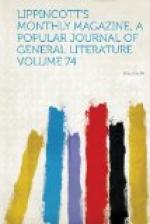Wait you for love? ’Tis worth the waiting for.
God put a power of closer tenderness
In mine than in most women’s souls. Who thrills
The senses, holds the heart, in all inspiring
Ways sweetens and magnifies to good
Love’s life, conceiving colder estimate
Of love? So will I love you, without stint.
Compare this feeble and disjointed utterance with the corresponding speech in Swinburne’s play. Mary says:
O
my fair lord!
How fairer is this warrior face, and eyes
With the iron light of battle in them,
left
As the after-fire of sunset left in heaven
When the sun sinks, than any fool’s
face made
Of smiles and courtly color! Now
I feel
As I were man too, and had part myself
In your great strength; being one with
you as I,
How should I not be strong?
Cartoons. By Margaret J. Preston. Boston: Roberts Brothers.
If Mrs, Aitken’s poems suggest Mrs. Browning’s, these Cartoons of Mrs. Preston’s have a slight flavor of Robert Browning’s Men and Women in their subjects and in their mode of thought. A cartoon is usually supposed to be a design for tapestry or mosaic, but we suppose that Mrs. Preston has taken the significance given the word by our illustrated papers, where it is held to mean a large outline sketch. The title is not a very happy one, but the poems, are much better than the title. They are strong, simple and well-written, and the subjects are usually very well chosen. They are divided into “Cartoons from the Life of the Old Masters,” “Cartoons from the Life of the Legends” and “Cartoons from the Life of To-day.” Of these, the second division is perhaps the weakest, the first the most interesting, while the third makes up in religious sentiment what it lacks in poetic strength and beauty. It contains more commonplace verses and ideas than either of the other two. Of the stories of the old masters, “Mona Lisa’s Picture,” “The Duke’s Commission” and “Woman’s Art” are perhaps the best, and the last poem especially is very spirited and terse. Mrs. Preston’s style has the rare merit in these days of uniting conciseness and directness to grace and beauty of expression. Her greatest failing is a lack of the sense of climax. There are several of these poems, like the two on the Venerable Bede and that called “Bacharach Wine,” that rather disappoint one by the insignificance of their closing stanzas or the gradual dwindling of their interest toward the end. There is a great deal of art in knowing when to stop, and there are many stories, like some of those in this book, that are very impressive told in a few words, but elaborated into a long poem lose all their power to move us. At the same time, we realize that it is not from any poverty of ideas that Mrs. Preston sometimes dwells too long upon a subject: her poetry is not diluted with a mere harmonious jingle of words, as destitute




